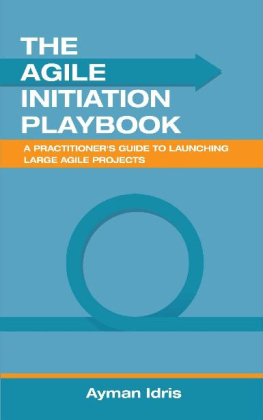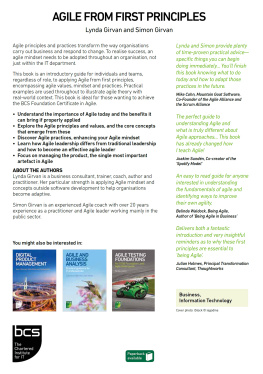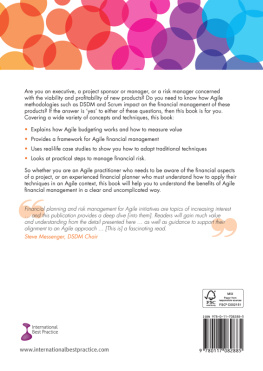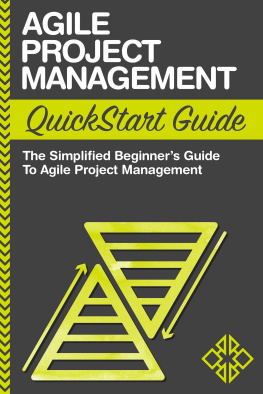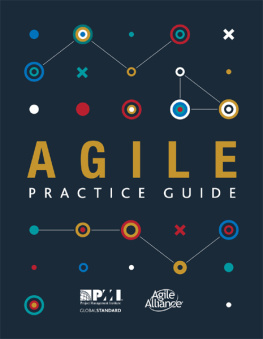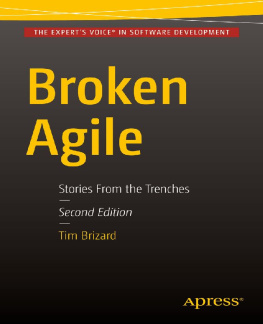Ayman Idris - The Agile Initiation Playbook: A Practitioners Guide to Launching Large Agile Projects
Here you can read online Ayman Idris - The Agile Initiation Playbook: A Practitioners Guide to Launching Large Agile Projects full text of the book (entire story) in english for free. Download pdf and epub, get meaning, cover and reviews about this ebook. year: 2020, publisher: Ayman Idris, genre: Business. Description of the work, (preface) as well as reviews are available. Best literature library LitArk.com created for fans of good reading and offers a wide selection of genres:
Romance novel
Science fiction
Adventure
Detective
Science
History
Home and family
Prose
Art
Politics
Computer
Non-fiction
Religion
Business
Children
Humor
Choose a favorite category and find really read worthwhile books. Enjoy immersion in the world of imagination, feel the emotions of the characters or learn something new for yourself, make an fascinating discovery.
- Book:The Agile Initiation Playbook: A Practitioners Guide to Launching Large Agile Projects
- Author:
- Publisher:Ayman Idris
- Genre:
- Year:2020
- Rating:5 / 5
- Favourites:Add to favourites
- Your mark:
- 100
- 1
- 2
- 3
- 4
- 5
The Agile Initiation Playbook: A Practitioners Guide to Launching Large Agile Projects: summary, description and annotation
We offer to read an annotation, description, summary or preface (depends on what the author of the book "The Agile Initiation Playbook: A Practitioners Guide to Launching Large Agile Projects" wrote himself). If you haven't found the necessary information about the book — write in the comments, we will try to find it.
Ayman Idris: author's other books
Who wrote The Agile Initiation Playbook: A Practitioners Guide to Launching Large Agile Projects? Find out the surname, the name of the author of the book and a list of all author's works by series.
The Agile Initiation Playbook: A Practitioners Guide to Launching Large Agile Projects — read online for free the complete book (whole text) full work
Below is the text of the book, divided by pages. System saving the place of the last page read, allows you to conveniently read the book "The Agile Initiation Playbook: A Practitioners Guide to Launching Large Agile Projects" online for free, without having to search again every time where you left off. Put a bookmark, and you can go to the page where you finished reading at any time.
Font size:
Interval:
Bookmark:
THE
AGILE INITIATION PLAYBOOK
A Practitioners Guide to
Launching Large Agile Projects
Copyright 2020 by Ayman Idris
All Rights Reserved. Except as permitted under U.S. Copyright Act of 1976, no part of this publication may be reproduced, stored in a database or retrieval system, or transmitted, in any form or by any means, electronic, mechanical, photocopying, recording, or otherwise, without the prior written permission of Ayman Idris.
Table of Contents
PART 1: SETTING THE STAGE
This part is divided into three chapters that introduce the concepts of Agile project initiation and the Initiation Sprint, and provide a step-by-step roadmap to setting the stage for the Initiation Sprint.
Chapter 1: The Initiation Sprint Chapter 2: Project Rubicon Chapter 3: Prepare for the Initiation Sprint |
Chapter 1: The Initiation Sprint
Introduction
... And this is what I love the most about Agile, gushed the seasoned software engineering manager as he devoured his second serving of sushi, his appetite only matched by his enthusiasm. Were constantly in doing mode. The suits in finance and marketing dont get it, but you dodont you? We dont have time to waste on interminable planning sessions every time we start a new project. To hell with planning. Youve got an idea? Great! Lets build it and see if it works! Its magic, I tell ya. Magic!
In my almost twelve years as an Agile coach working with tens of organizations, Ive heard many variations of the same point he made: that Agile liberates us from the onerous burden of having to spend any time at the beginning of a new software project or initiative to plan what to do. We just dive in and write code. Those who espouse this belief will tell you that any plan becomes irrelevant almost the moment it is produced, and therefore any attempt to spend some timehowever shortat the beginning of a new project to try to figure out what it is we really need to do is futile.
Common sense, of course, tells a different story: while it is true (as evidence has shown time and again) that, in the highly complex and ever-changing world of technology, wasting months after months in pursuit of a perfect plan of work to address a complex problem is simply not the best way to go, we still need some sort of broad alignment between our various stakeholders on the projects initial direction.
And the need is evidently more profound when the project is large and complex. How can we plunge into coding if we do not have a common understanding of what the desired outcomes are for our customers and for the business, for example? Or without confirming whether everyone is on the same page regarding why our current approach to solving the customer problem or need is no longer viable? Or without building a shared understanding of what our customers actually want and need? Or without discussing our different working styles as team members and how we can work best together? etc. I cannot think of a situation in which not having those discussions early in the project bodes well for the projects future.
This book lays out in detail how I help teams create that initial broad alignment as we kick off a new software project. During a three-week period of intensive collaboration that I call the Initiation Sprint, I work with a cross-functional team comprised of those with a stake in the project to explore some of the key themes and questions mentioned above, so that we start the project on the right foot.
The book follows, in a step-by-step fashion, a recent Initiation Sprint I facilitated for a large, APAC-based bank, detailing the different activities and exercises we embarked on as we initiated the project: exploring the problem; creating a shared understanding of what success means to our customers and to the business; and discussing the features that will help us achieve that success. I will discuss the particulars of that project and the circumstances surrounding the Initiation Sprint in Chapter 2.
This is a highly practical, hands-on book. My aim is that, once you have read it, you will be able to confidently and successfully facilitate an Initiation Sprint end-to-end, even if you havent facilitated anything of that magnitude before. There wont be any drawn-out discussions of Agile concepts and theories. Rather, concepts, theories and principles are only discussed in the context of putting them into real-life application.
Who is this book for?
I wrote this book for people who will be facilitating, supporting, sponsoring or participating in the initiation of an Agile project. You do not need to be an Agile expert or a master facilitator to understand and apply the approach laid out in this book, although basic Agile knowledge is necessary.
So, what happens exactly in the Initiation Sprint?
When initiating a software project, the team embarks on an effort to explore three core initiation dimensions that are critical for success:
Product: What exactly is the customer problem that we need to solve? Who has that problem? Why is it worth solving? What are the overall business and customer goals that we hope to achieve by solving this problem? What would the solution look like? How do we know that we have successfully solved the problem? This is essentially what many refer to as product discovery.
Process: How are we going to work together to solve that problem? What are the meetings, artifacts, roles, governance checkpoints, standards, tools, etc., that define our Way of Working? What tools and technical practices will allow us to create the best product possible?
People: Who are the people solving this problem? What are our aspirations? Preferences? Strengths and weaknesses? Working styles? How can we bring out the best in each other? What is our social contract as we take on this formidable challenge?
Pause for a second and examine this list again. Is there anything that made you think, Hmm... I dont see any value in asking this question prior to commencing development work.? If not, then thats why we need the Initiation Sprint.
Initiation is not about finding final answers to these questions (or others). Initiation is a process of exploration, the purpose of which is to build a shared understanding of the different aspects of the problem among the team. By providing the team with many opportunities to reflect on, share, and challenge assumptions, the team emerges from the Initiation Sprint not only with a plan for how to start building the product, but also with a collective recognition of the challenges that they need to work through together, an acknowledgment that no one party has all the answers, and a sense of appreciation and empathy towards one anotherqualities that would serve the team well throughout the project.
Flow and deliverables of the Initiation Sprint
The Initiation Sprint contains activities and exercises that are designed to address the three initiation dimensions mentioned above (Product, Process, and People). Over the course of fifteen days, the team:
- --- Explores the business drivers and expected outcomes for the business and the customerthe Why of the project. The outputs of this exploration include the projects definition of success and the projects Lean Canvas (one-pager)
- --- Explores the current-stateas-issituation: How are we addressing the problem at the moment (current products/offerings addressing the customer need)? What are the deficiencies/pain points/inefficiencies, etc., that necessitated finding a new answer to the business problem? (from different perspectives: customer, business, technology)the outputs of that exploration include
Next pageFont size:
Interval:
Bookmark:
Similar books «The Agile Initiation Playbook: A Practitioners Guide to Launching Large Agile Projects»
Look at similar books to The Agile Initiation Playbook: A Practitioners Guide to Launching Large Agile Projects. We have selected literature similar in name and meaning in the hope of providing readers with more options to find new, interesting, not yet read works.
Discussion, reviews of the book The Agile Initiation Playbook: A Practitioners Guide to Launching Large Agile Projects and just readers' own opinions. Leave your comments, write what you think about the work, its meaning or the main characters. Specify what exactly you liked and what you didn't like, and why you think so.

